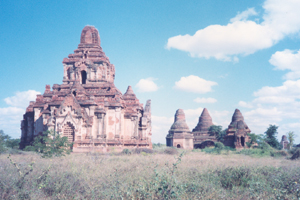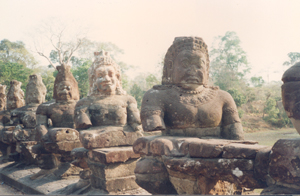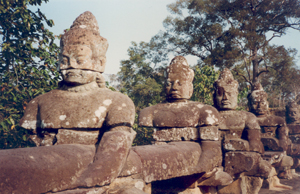RUINS ALONG THE MEKONG
Story and Pix by Geraldine Goh
.jpg) Travelling across the Mekong Basin in Southeast Asia, you will get to see the wonders of past civilizations through the interesting ruins of ancient temples that dot the countryside.
Travelling across the Mekong Basin in Southeast Asia, you will get to see the wonders of past civilizations through the interesting ruins of ancient temples that dot the countryside.
The Mingun Temple in Mandalay, Myanmar, is the largest temple in the country. It is 30 metres high and was built more than two centuries ago during the reign of King Bodaw Pharar (1782-1819).

At this temple, you can find the world�s largest bell that is three times the height of a man.
To get to the Mingun Temple, you have to take a slow boat ride along the Ayeyarwaddy River (pronounced as A-yar-waddy) from Mandalay.
The 45-minute ride gives you a glimpse of life along the riverbanks.

Further south of Mandalay are the temple ruins of Bagan.
More than a thousand temples were built in this area between the 11th and 13th centuries by the rulers of Bagan like King Anawratha (1044-1077) who built the Shwesanda Temple; King Kyansittha (1084-1113) who built the Ananda Temple; King Alaungsithu (1113-1163) who erected the Thatbyinnu Temple; and King Narapatisithu (1174-1211) who built the Gawdawpalin Temple.
To get around the various temples spread across 40 square kms, it is best to use a pony cart, which you can rent by the hour for a small fee.

Don�t try the bullock cart for it would take twice as long to cover the area as they tend to stroll along at their own pace and stop and graze while you get scorched by the sun.
Across the border in neighbouring Thailand, you can see the famous ruins of Ayutthaya located about 70 kms north of Bangkok, about an hour�s drive away.

You can also take a boat ride on the Chao Phraya River in the Thai capital that will take you all the way to Ayutthaya and then drive back to the city or vice-versa.
These ruins date back to the 14th century at a time when Ayutthaya was the ancient seat of power in the Kingdom of Siam (which was later re-named as Thailand).
It was the capital of Siam from 1350-1767.
The historical park is accessible by car and foot.

The more spectacular temples in the Mekong region are found in Cambodia, home to the Angkor Wat, the world�s largest Hindu temple complex.
It is located in the northern town of Siem Reap. Here, you can also find the Bayon Temple.

These religious monuments were built between the 8th and 15th centuries at the height of the Khmer kingdom that had been ruled by the Suryavarman and Jayavarman empires.

The magnificence of the Bayon Temple lies in the exquisite beauty of its architecture that features the giant faces of King Jayavarman VII, which some believe were modeled after the Buddha.
Stone carvings embellish the walls of the temple, which was inspired by a mixture of Hinduism and Buddhism.

How to Get There
It is best to make Bangkok the travel base and from there, it is easy to get regular flights out to Myanmar and Cambodia.
You can fly Thai Airways International to Yangon and Phnom Penh and then take the domestic flights to Bagan, Mandalay or Siem Reap.
Or you can use Myanmar Airways International and Cambodian air carriers from Bangkok to the respective capitals and then connect with the domestic routes.
Another way is to fly the smaller airlines like Bangkok Airways and Siem Reap Airways that connect Bangkok with Siem Reap. Or you can fly Mekong Air from Bangkok to the Cambodian capital, Phnom Penh, and then connect to Siem Reap.

You can also fly Air Mandalay from the northern Thai city of Chiang Mai to Mandalay and then take a connecting flight to Bagan.
Where to Stay
There is the 5-star Sedona Hotel in Mandalay as well as the 4-star Novotel Hotel, while in Bagan there is the Thiripyitsayar Hotel. Prices are in US dollars.
Smaller locally managed hotels and inns are also available for much less.
In Siem Reap, there is the 5-star Sofitel Royal Angkor and Grand D�Angkor Hotel, as well as other local hotels and budget accommodation.